Cook Inlet Gull (Herring x Glaucous-winged Gull hybrid) Identification in Alaska

Even for experienced birders, gull identification can be tricky – and, to make matters worse, they hybridize! Gull hybrids are fertile and may breed with each other or either parent species, so individuals in a hybrid swarm can span the full spectrum from one parent species to the other.
In Alaska, the most frequently observed hybrid gull is the Herring x Glaucous-winged Gull hybrid. This hybrid combination is informally called the “Cook Inlet Gull” because many of the large breeding colonies are located around the Cook Inlet. Here we will talk about adult Cook Inlet Gulls, where they occur in summer, and the variation in characteristics that often gets them confused with one of the pure species (Herring Gull or Glaucous-winged Gull).
Where do Cook Inlet Gulls occur?
Despite the unofficial name, Cook Inlet Gull hybrids breed across much of Southcentral Alaska from the Cook Inlet in the west to at least Glacier Bay in the east. Colonies of mixed Glaucous-winged Gulls and Herring x Glaucous-winged Gull hybrids have been found in Lake Iliamna, barrier islands in the Copper River Delta, Yakutat Bay, and Glacier Bay (Patten 1980). Herring x Glaucous-winged Gull hybrid colonies without pure parent species are found on the Kenai River, Skilak Lake, Susitna Flats, Anchorage, and Palmer Slough (Williamson and Peyton 1963). While historical research and collecting trips first identified this hybrid combination at most of the colonies in Figure 1 (Williamson and Peyton 1963, Patten 1980), recent information on their distribution is somewhat limited due to the challenge of correctly identifying hybrids. Click here for a map of Cook Inlet Gull sightings reported to eBird.

Figure 1. Presumed breeding range of Cook Inlet Gulls (Herring x Glaucous-winged Gulls hybrids) in Alaska and known colonies with hybrid Cook Inlet Gulls. Colonies in the Cook Inlet region (Kenai, Anchorage, Palmer) are almost entirely hybrids while colonies between the Copper River Delta and Glacier Bay are a mixture of Glaucous-winged Gulls and Cook Inlet Gulls.
Glaucous-winged Gulls are strongly associated with marine habitats and usually breed on the coast. Herring Gulls tend to breed inland, but they’re more flexible. When Herring Gulls breed near or at the coast, that’s when hybridization occurs. In summer, almost all large gulls in the Upper Cook Inlet (Anchor Point to Palmer) are hybrids; pure Herring or Glaucous-winged Gulls are not known to breed in this region, although they can pass through during migration. However, as you travel south from Anchor Point to Homer and the Gulf of Alaska, you will begin finding pure-looking Glaucous-winged Gulls. Conversely, as you drive north and east from the Upper Cook Inlet to Fairbanks and Glennallen, you will encounter an increasing proportion of pure-looking Herring Gulls. These general ranges can help guide where and when to expect Cook Inlet Gulls, but it would be problematic to only identify gulls on range alone. These two species are closely related and hybrids contain traits of both parent species. Using a combination of features including primary color, eye color, and orbital ring color are necessary when identifying individuals.
Primaries
Herring Gulls have black wingtips, Glaucous-winged Gulls have gray, and Cook Inlet hybrids have something in-between. On a Herring Gull, the end of each primary feather is fully black when viewed from above and mostly black from below. On a Glaucous-winged Gull, the end of each primary is gray (similar in color to the mantle) above and even lighter below. Hybrids are intermediate between these two species and can appear dark-gray to fully black above and usually light-gray to gray below. The almost black upper side and silvery gray undersides to the primary tips is a good indicator of a hybrid bird and can be seen in flight or at rest (Figure 2). When observing a bird in flight from below, the primary color can appear light gray like a Glaucous-winged Gull. We do not recommend identifying birds as Glaucous-winged Gulls based only on views or photos of the undersides of the primaries. On hybrids that are near the Herring end of the spectrum, the underside of the primaries can show some black, but the extent is more limited than on a pure Herring Gull.
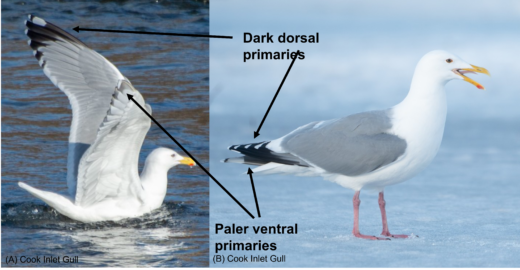
Figure 2. Cook Inlet Gull (Herring x Glaucous-winged Gull hybrid) dorsal and ventral primary coloration. Photo A – Emily Weiser (Anchorage, AK in April) and Photo B – Sulli Gibson (Anchorage, AK in April).
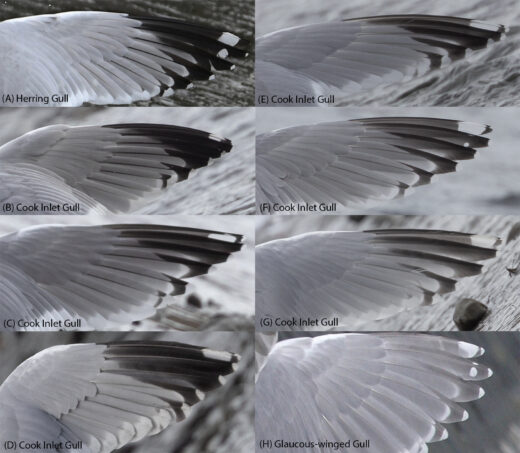
Figure 3. Herring Gull, Cook Inlet Gull (Herring x Glaucous-winged Gull hybrid), and Glaucous-winged Gull primaries (dorsal side) showing variation in color from black (similar to Herring Gull) to gray (similar to Glaucous-winged Gull). Photo A – Arav and Aranya Karighattam (Middlesex, MA in April), Photo B-G – Zak Pohlen (Anchorage, AK in April), Photo H – Steve Rottenborn (Santa Clara, CA in December).
When examining the open wing more closely, a Cook Inlet hybrid will show faded or gray inner webs of the outer primaries rather than true black. This contrast with the darker black outer web (often fully black) produces a striped look, sometimes called the “venetian blind” effect. This can be seen in Figure 3 and Figure 4, but it can be hard to discern when the feathers are not spread (Figure 2 top right and bottom right).
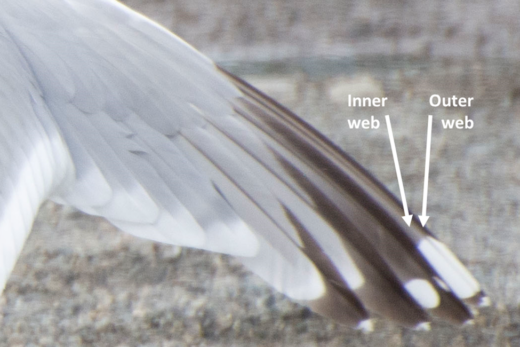
Figure 4. Outstretched right wing of a Cook Inlet Gull (Herring x Glaucous-winged Gull hybrid) showing the contrast between dark outer webs (to the right of the feather’s central quill) and paler inner webs (to the left of the feather’s central quill) on the outer primaries, creating a “venetian blind” effect. Photo taken in July in Anchorage, AK by Emily Weiser.
Orbital ring
The “orbital ring” is the rim of bare skin around a bird’s eye. Outside of the breeding season, the orbital ring tends to be thin and pale, but it becomes thicker and more brightly colored in the breeding season. With a close view or a good photograph, the color can often be identified. This is not a failsafe way to distinguish hybrids from pure birds, but can often be helpful if the orbital ring color contradicts the primary or eye color. Herring Gulls have yellow-orange orbital rings and Glaucous-winged Gulls have pink orbital rings. Cook Inlet Gull orbital ring color variation and classic Herring and Glaucous-winged Gull orbital ring color can be seen in Figure 5.

Figure 5. Herring Gull, Cook Inlet Gull (Herring x Glaucous-winged Gull hybrid) and Glaucous-winged Gull orbital ring color variation from yellow (similar to Herring Gull) to pink (similar to Glaucous-winged Gull) and intermediate yellow and pink varieties. Photo A – Cameron Eckert (Whitehorse, YT in July) , Photos B-E – Zak Pohlen (Anchorage, AK in April), Photo F – Josiah Verbrugge (Kenai Peninsula, AK in June).
Eye color
Like all other features, hybrid eye color is intermediate between Herring Gull (yellow) and Glaucous-winged Gull (dark) but can include either end of the spectrum. Hybrids can have either an almost completely yellow eye to a completely dark eye, but most have some mottled-yellow or brown speckling. Cook Inlet Gull eye color variation and classic Herring and Glaucous-winged Gull eye colors can be seen in Figure 6.
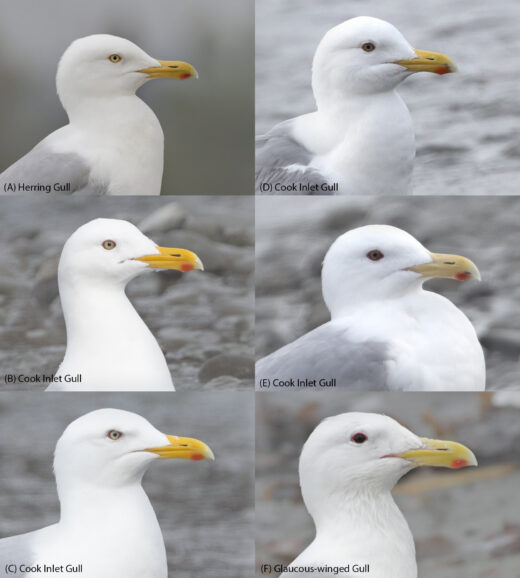
Figure 6. Herring Gull, Cook Inlet Gull (Herring x Glaucous-winged Gull hybrid) and Glaucous-winged Gull eye color variation from yellow (similar to Herring Gull) to pink (similar to Glaucous-winged Gull) and intermediate yellow and pink varieties. Photo A – Cameron Eckert (Whitehorse, YT in July) , B-E – Zak Pohlen (Anchorage, AK in April), Photo F – Ian Davies (Kenai Peninsula, AK in July).
Conclusion
The Cook Inlet Gull is a common bird in the Cook Inlet region and can be found across Southcentral Alaska to Glacier Bay in the east. If you observe a pure Herring or Glaucous-winged candidate within the known hybrid contact zone (especially in the Upper Cook Inlet), please investigate the following list of traits for each species to insure the bird is not one of the more common hybrids.
Herring Gull
- Is the dorsal side of the primaries fully black (without pale inner webs)?
- Is the ventral side of the primaries extensively dark?
- Is the orbital ring yellow-orange?
- Is the eye entirely pale/yellow?
Glaucous-winged Gull
- Are the primary tips the same color as the mantle (light gray)?
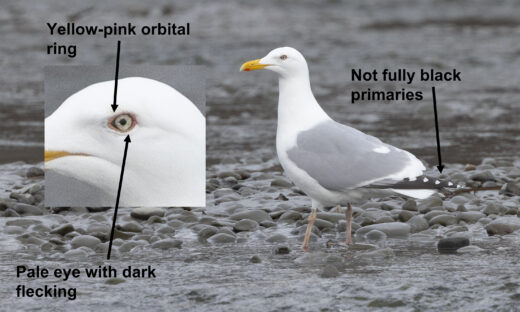
Figure 7. A Cook Inlet Gull (Herring x Glaucous-winged Gull hybrid) showing the contrasting features between Herring Gull and Glaucous-winged Gull. Note the yellow (Herring Gull influence) and pink (Glaucous-winged Gull influence) orbital ring, the pale eye (Herring Gull influence) with dark flecking (Glaucous-winged Gull influence), and the primaries being darker than the mantle (Herring Gull influence) but not fully black (Glaucous-winged Gull influence). Photo taken in April in Anchorage, AK by Zak Pohlen.
Reporting in eBird
If you’ve identified a bird as a hybrid, be sure to use the hybrid option. For Cook Inlet Gulls, the correct entry in eBird is “Herring x Glaucous-winged Gull (hybrid).”
If a bird is too far away for a good look, if you don’t have time to study it, or if it simply has you stumped, we recommend the “slash” entry of “Herring/Glaucous-winged Gull.” The “slash” option represents either a Herring Gull, a Glaucous-winged Gull, or a hybrid between the two.
Alternatively, if you can’t even narrow it down to either of the two species, such as a very distant bird or a case where you’re not sure whether it is a Cook Inlet Gull or a Thayer’s Gull, use the “gull sp.” option. When in doubt, don’t guess. Just report it to whatever level you can be sure is correct. Using “gull sp.” is a perfectly acceptable identification for many distant, difficult, or worn individuals!
Please upload photos!
There is a surprisingly small number of photos of Cook Inlet Gulls from Alaska in eBird and the Macaulay Library. Adding photos to your checklist will not only help you check your identification, but also adds to the visual database used by birders and scientists. These photos are important to help scientists establish where and how large the hybrid zone is and help birders better understand all the possible variation in character traits.
Williamson, F.S. and L.J. Peyton. 1963. Interbreeding of Glaucous-winged and Herring gulls in the Cook Inlet region, Alaska. Condor, pp.24-28.
Patten Jr., S.M. 1980. Interbreeding and evolution in the Larus glaucescens – Larus argentatus complex on the south coast of Alaska. Ph.D Thesis. The Johns Hopkins University. Baltimore, MD.
Article by: Emily Weiser and Zak Pohlen
